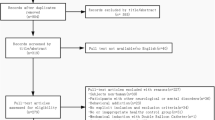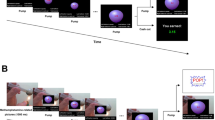Abstract
Background
Relapse remains the major challenge in treatment of alcohol use disorder (AUD). Aberrant decision-making has been found as important cognitive mechanism underlying relapse, but factors associated with relapse vulnerability are unclear. Here, we aim to identify potential computational markers of relapse vulnerability by investigating risky decision-making in individuals with AUD.
Methods
Forty-six healthy controls and fifty-two individuals with AUD were recruited for this study. The risk-taking propensity of these subjects was investigated using the balloon analog risk task (BART). After completion of clinical treatment, all individuals with AUD were followed up and divided into a non-relapse AUD group and a relapse AUD group according to their drinking status.
Results
The risk-taking propensity differed significantly among healthy controls, the non-relapse AUD group, and the relapse AUD group, and was negatively associated with the duration of abstinence in individuals with AUD. Logistic regression models showed that risk-taking propensity, as measured by the computational model, was a valid predictor of alcohol relapse, and higher risk-taking propensity was associated with greater risk of relapse to drink.
Conclusion
Our study presents new insights into risk-taking measurement and identifies computational markers that provide prospective information for relapse to drink in individuals with AUD.




Similar content being viewed by others
References
Degenhardt L, Charlson F, Ferrari A et al (2018) The global burden of disease attributable to alcohol and drug use in 195 countries and territories, 1990–2016: a systematic analysis for the Global Burden of Disease Study 2016. The Lancet Psychiatry 5(12):987–1012
Grant BF (1997) Prevalence and correlates of alcohol use and DSM-IV alcohol dependence in the United States: results of the national longitudinal alcohol epidemiologic survey. J Stud Alcohol 58(5):464–473
Hasin DS, Stinson FS, Ogburn E, Grant BF (2007) Prevalence, correlates, disability, and comorbidity of DSM-IV alcohol abuse and dependence in the United States—Results from the National Epidemiologic Survey on Alcohol and Related Conditions. Arch Gen Psychiatry 64(7):830–842
Schuckit MA (2009) Alcohol-use disorders. Lancet 373(9662):492–501
Carvalho AF, Heilig M, Perez A, Probst C, Rehm J (2019) Alcohol use disorders. Lancet 394(10200):781–792
Lim SS, Vos T, Flaxman AD et al (2012) A comparative risk assessment of burden of disease and injury attributable to 67 risk factors and risk factor clusters in 21 regions, 1990–2010: a systematic analysis for the Global Burden of Disease Study 2010. Lancet 380(9859):2224–2260
Krishnan KRR (2005) Psychiatric and medical comorbidities of bipolar disorder. Psychosom Med 67(1):1–8
Lejuez CW, Read JP, Kahler CW et al (2002) Evaluation of a behavioral measure of risk taking: the Balloon Analogue Risk Task (BART). J Exp Psychol Appl 8(2):75–84
Kathleen Holmes M, Bearden CE, Barguil M et al (2009) Conceptualizing impulsivity and risk taking in bipolar disorder: importance of history of alcohol abuse. Bipolar Disord 11(1):33–40
Wang J, Fan Y, Dong Y, et al. Alterations in Brain Structure and Functional Connectivity in Alcohol Dependent Patients and Possible Association with Impulsivity. Plos One. 2016;11(8).
Sui XY, Zhang MM, Yuan TF, Rao LL. Impaired Outcome Evaluation During Risky Decision-Making in Individuals with Methamphetamine Use Disorder. International Journal of Mental Health and Addiction. 2022.
Rieser NM, Shaul L, Blankers M, Koeter MWJ, Schippers GM, Goudriaan AE. The Predictive Value of Impulsivity and Risk-Taking Measures for Substance Use in Substance Dependent Offenders. Frontiers in Behavioral Neuroscience. 2019;13.
Liu ZY, Huang PJ, Gong Y, et al. Altered neural responses to missed chance contribute to the risk-taking behaviour in individuals with Internet gaming disorder. Addiction Biology. 2022;27(2).
Asaoka Y, Won M, Morita T, Ishikawa E, Goto Y (2020) Higher risk taking and impaired probability judgment in behavioral addiction. Int J Neuropsychopharmacol 23(10):662–672
Klepper S, Odenwald M, Rosner S et al (2017) Experience-induced change of alcohol-related risk perception in patients with alcohol use disorders. Front Psychol 8:1967
Aloi J, Blair KS, Crum KI et al (2020) Alcohol use disorder, but not cannabis use disorder, symptomatology in adolescents is associated with reduced differential responsiveness to reward versus punishment feedback during instrumental learning. Biol Psychiatry Cogn Neurosci Neuroimaging 5(6):610–618
Galandra C, Crespi C, Basso G, Canessa N (2020) Impaired learning from regret and disappointment in alcohol use disorder. Sci Rep 10(1):12104
Sehrig S, Weiss A, Miller GA, Rockstroh B. Decision- and feedback-related brain potentials reveal risk processing mechanisms in patients with alcohol use disorder. Psychophysiology. 2019;56(12).
Xie C, Yuan L, Meng Y, Wang K (2017) Alcohol-dependent individuals make detrimental decisions under ambiguous and perilous conditions. Int J Ment Heal Addict 16(4):956–964
Brevers D, Bechara A, Cleeremans A, Kornreich C, Verbanck P, Noel X (2014) Impaired decision-making under risk in individuals with alcohol dependence. Alcohol Clin Exp Res 38(7):1924–1931
Prisciandaro JJ, Rembold J, Brown DG, Brady KT, Tolliver BK (2011) Predictors of clinical trial dropout in individuals with co-occurring bipolar disorder and alcohol dependence. Drug Alcohol Depend 118(2–3):493–496
Fernie G, Peeters M, Gullo MJ et al (2013) Multiple behavioural impulsivity tasks predict prospective alcohol involvement in adolescents. Addiction 108(11):1916–1923
Murray DE, Durazzo TC, Mon A, Schmidt TP, Meyerhoff DJ (2015) Brain perfusion in polysubstance users: Relationship to substance and tobacco use, cognition, and self-regulation. Drug Alcohol Depend 150:120–128
Kim ST, Hwang SS, Kim HW et al (2018) Multidimensional impulsivity as a mediator of early life stress and alcohol dependence. Sci Rep 8(1):4104
Fernie G, Cole JC, Goudie AJ, Field M (2010) Risk-taking but not response inhibition or delay discounting predict alcohol consumption in social drinkers. Drug Alcohol Depend 112(1–2):54–61
Wang J, Fan Y, Dong Y, et al. Combining gray matter volume in the cuneus and the cuneus-prefrontal connectivity may predict early relapse in abstinent alcohol-dependent patients. Plos One. 2018;13(5).
Hamilton KR, Felton JW, Risco CM, Lejuez CW, MacPherson L (2014) Brief report: The interaction of impulsivity with risk-taking is associated with early alcohol use initiation. J Adolesc 37(8):1253–1256
Worhunsky PD, Dager AD, Meda SA et al (2016) A preliminary prospective study of an escalation in “maximum daily drinks”, fronto-parietal circuitry and impulsivity-related domains in young adult drinkers. Neuropsychopharmacology 41(6):1637–1647
Thompson LL, Claus ED, Mikulich-Gilbertson SK et al (2012) Negative reinforcement learning is affected in substance dependence. Drug Alcohol Depend 123(1–3):84–90
Courtney KE, Arellano R, Barkley-Levenson E et al (2012) The relationship between measures of impulsivity and alcohol misuse: an integrative structural equation modeling approach. Alcoholism-Clin Exp Res 36(6):923–931
Konova AB, Lopez-Guzman S, Urmanche A et al (2020) Computational markers of risky decision-making for identification of temporal windows of vulnerability to opioid use in a real-world clinical setting. JAMA Psychiat 77(4):368–377
Ai H, Li J, Zhang Y, Ma X, Yuan T-F, Xu P. Methamphetamine impairs social conformity during risk decision-making. Human Behaviour and Brain. 2020:74–78.
Mollick JA, Kober H (2020) Computational models of drug use and addiction: a review. J Abnorm Psychol 129(6):544–555
Smith R, Taylor S, Bilek E (2021) Computational mechanisms of addiction: recent evidence and its relevance to addiction medicine. Curr Addict Rep 8(4):509–519
Liu SY, Dolan RJ, Heinz A (2020) Translation of computational psychiatry in the context of addiction. JAMA Psychiat 77(11):1099–1100
Padovano HT, Janssen T, Emery NN, Carpenter RW, Miranda R Jr (2019) Risk-taking propensity, affect, and alcohol craving in adolescents’ daily lives. Subst Use Misuse 54(13):2218–2228
Neal LB, Gable PA (2019) Shifts in frontal asymmetry underlying impulsive and controlled decision-making. Biol Psychol 140:28–34
Ellingson JM, Potenza MN, Pearlson GD (2018) Methodological factors as a potential source of discordance between self report and behavioral measures of impulsivity and related constructs. Addict Behav 84:126–130
Caneto F, Marcos Pautassi R, Pilatti A (2018) Ethanol-induced autonomic responses and risk taking increase in young adults with a positive family history of alcohol problems. Addict Behav 76:174–181
Burnette EM, Grodin EN, Ghahremani DG, et al. Diminished cortical response to risk and loss during risky decision making in alcohol use disorder. Drug and Alcohol Dependence. 2021;218.
Edition F (2013) Diagnostic and statistical manual of mental disorders. Am Psychiatric Assoc 21:591–643
Flannery BA, Volpicelli JR, Pettinati HM (1999) Psychometric properties of the penn alcohol craving scale. Alcoholism-Clin Exp Res 23(8):1289–1295
Beck AT, Steer RA, Garbin MG (1988) Psychometric properties of the beck depression inventory—25 years of evaluation. Clin Psychol Rev 8(1):77–100
Beck AT, Erbaugh J, Ward CH, Mock J, Mendelsohn M (1961) An inventory for measuring depression. Arch Gen Psychiatry 4(6):561–570
Patton JH, Stanford MS, Barratt ES (1995) Factor structure of the Barratt impulsiveness scale. J Clin Psychol 51(6):768–774
van Ravenzwaaij D, Dutilh G, Wagenmakers E-J (2011) Cognitive model decomposition of the BART: assessment and application. J Math Psychol 55(1):94–105
Park H, Yang J, Vassileva J, Ahn W-Y. Development of a novel computational model for the Balloon Analogue Risk Task: The exponential-weight mean–variance model. Journal of Mathematical Psychology. 2021;102.
Ahn WY, Haines N, Zhang L (2017) Revealing neurocomputational mechanisms of reinforcement learning and decision-making with the hBayesDM package. Comput Psychiatr 1:24–57
Wallsten TS, Pleskac TJ, Lejuez CW (2005) Modeling behavior in a clinically diagnostic sequential risk-taking task. Psychol Rev 112(4):862–880
Gilman JM, Calderon V, Curran MT, Evins AE (2015) Young adult cannabis users report greater propensity for risk-taking only in non-monetary domains. Drug Alcohol Depend 147:26–31
Coffey SF, Schumacher JA, Baschnagel JS, Hawk LW, Holloman G (2011) Impulsivity and Risk-Taking in Borderline Personality Disorder With and Without Substance Use Disorders. Personality Disorders-Theory Res Treatment 2(2):128–141
Goudriaan AE, Grekin ER, Sher KJ (2011) Decision making and response inhibition as predictors of heavy alcohol use: a prospective study. Alcoholism-Clin Exp Res 35(6):1050–1057
Ellingson JM, Corley R, Hewitt JK, Friedman NP (2019) A prospective study of alcohol involvement and the dual-systems model of adolescent risk-taking during late adolescence and emerging adulthood. Addiction 114(4):653–661
Pacheco-Colon I, Lopez-Quintero C, Coxe S et al (2022) Risky decision-making as an antecedent or consequence of adolescent cannabis use: findings from a 2-year longitudinal study. Addiction 117(2):392–410
Aklin WM, Lejuez CW, Zvolensky MJ, Kahler CW, Gwadz M (2005) Evaluation of behavioral measures of risk taking propensity with inner city adolescents. Behav Res Ther 43(2):215–228
Clay JM, Parker MO (2018) The role of stress-reactivity, stress-recovery and risky decision-making in psychosocial stress-induced alcohol consumption in social drinkers. Psychopharmacology 235(11):3243–3257
Rose AK, Jones A, Clarke N, Christiansen P (2014) Alcohol-induced risk taking on the BART mediates alcohol priming. Psychopharmacology 231(11):2273–2280
Johnson SJ, Benson S, Scholey A, Alford C, Verster JC. Risk-Taking Behavior and the Consumption of Alcohol Mixed with Energy Drink among Australian, Dutch and UK Students. Int J Environ Res Publ Health. 2021;18(10).
Rolls ET, Wan Z, Cheng W, Feng JF. Risk-taking in humans and the medial orbitofrontal cortex reward system. Neuroimage. 2022;249.
MacPherson L, Magidson JF, Reynolds EK, Kahler CW, Lejuez CW (2010) Changes in sensation seeking and risk-taking propensity predict increases in alcohol use among early adolescents. Alcoholism-Clin Exp Res 34(8):1400–1408
Campbell JA, Samartgis JR, Crowe SF (2013) Impaired decision making on the balloon analogue risk task as a result of long-term alcohol use. J Clin Exp Neuropsychol 35(10):1071–1081
Funding
This study was provided by the Shandong Mental Health Center grant. The funding source had no role in the study design, collection, analysis of the data, writing the manuscript, or the decision to submit the paper for publication.
Author information
Authors and Affiliations
Corresponding authors
Ethics declarations
Conflict of interest
All other authors declare that they have no conflicts of interest that could affect this paper as reported.
Rights and permissions
Springer Nature or its licensor (e.g. a society or other partner) holds exclusive rights to this article under a publishing agreement with the author(s) or other rightsholder(s); author self-archiving of the accepted manuscript version of this article is solely governed by the terms of such publishing agreement and applicable law.
About this article
Cite this article
Yuan, W., Chen, M., Wang, DW. et al. Computational markers of risky decision-making predict for relapse to alcohol. Eur Arch Psychiatry Clin Neurosci 274, 353–362 (2024). https://doi.org/10.1007/s00406-023-01602-0
Received:
Accepted:
Published:
Issue Date:
DOI: https://doi.org/10.1007/s00406-023-01602-0




